
Donald Trump’s recent pronouncements on tariffs have once again ignited global economic discussions. In a bold statement via X, the former U.S. President asserted that tariffs should have been implemented ‘decades ago.’ This declaration arrives amidst swirling rumors and fake news reports, adding fuel to the fire of ongoing trade policy debates. Let’s delve into what this means and why it’s capturing headlines.
Why Trump’s Tariffs Are Making Waves
Trump’s advocacy for tariffs isn’t new, but his renewed emphasis has brought the topic back into the spotlight. His assertion that these measures should have been enacted much earlier suggests a long-held belief in their efficacy. But what exactly are tariffs, and why are they such a hot-button issue?
- What are Tariffs?: Simply put, tariffs are taxes imposed on imported goods and services. These taxes are typically paid by the importing business but can be passed on to consumers through higher prices.
- Trump’s Perspective: Trump views tariffs as a powerful tool to protect domestic industries, create jobs within the U.S., and reduce trade deficits. He believes they can incentivize companies to produce goods domestically rather than outsourcing production overseas.
- Global Implications: However, tariffs are not without controversy. They can lead to retaliatory tariffs from other countries, escalating into trade wars that harm global trade and economic growth.
The Fake News Factor: Tariff Waivers and Misinformation
Adding another layer of complexity, recent reports circulated by Reuters suggested that National Economic Council (NEC) Director Kevin Hassett mentioned Trump considering a 90-day tariff waiver for all countries except China. This news, however, was quickly debunked as fake. The spread of such misinformation highlights the volatile nature of economic news and the importance of verifying sources.
Why is fake news about tariffs so impactful?
- Market Sensitivity: Financial markets react strongly to trade policy news. Rumors of tariff waivers can cause market fluctuations, impacting investments and trading strategies.
- Investor Uncertainty: Unreliable information breeds uncertainty. Investors and businesses need accurate data to make informed decisions. Fake news disrupts this process.
- Erosion of Trust: The spread of false reports can erode trust in news sources and even government communications, making it harder to discern credible information.
Decoding Trump’s Trade Policy Stance
To understand the current situation, it’s crucial to examine Trump’s historical approach to trade policy. During his presidency, he implemented tariffs on goods from various countries, most notably China, leading to a significant trade dispute. His ‘America First’ agenda heavily influenced these decisions, prioritizing domestic manufacturing and reducing reliance on foreign imports.
Key elements of Trump’s trade policy approach:
| Policy | Description | Potential Impact |
|---|---|---|
| Section 232 Tariffs | Imposed tariffs on steel and aluminum imports based on national security grounds. | Boosted domestic steel and aluminum industries but increased costs for industries using these materials. |
| Section 301 Tariffs | Targeted tariffs on Chinese goods due to alleged unfair trade practices and intellectual property theft. | Led to a trade war with China, impacting various sectors and global supply chains. |
| Renegotiation of Trade Agreements | Replaced NAFTA with USMCA (United States-Mexico-Canada Agreement), aiming for more favorable terms for the U.S. | Modernized trade rules within North America but also introduced complexities. |
The Broader Impact on the US Economy and Global Trade
Trump’s emphasis on tariffs has significant implications for the US economy and global trade. While proponents argue that tariffs can protect domestic industries and jobs, critics point to potential negative consequences.
Potential Benefits of Tariffs (according to proponents):
- Protection of Domestic Industries: Tariffs can make imported goods more expensive, giving domestic producers a competitive edge.
- Job Creation: By encouraging domestic production, tariffs could potentially lead to job growth in manufacturing sectors.
- Reduced Trade Deficits: Tariffs aim to reduce imports, theoretically narrowing trade deficits.
- National Security: In strategic sectors like steel and aluminum, tariffs can be justified on national security grounds to ensure domestic production capacity.
Potential Challenges and Drawbacks of Tariffs:
- Increased Consumer Prices: Tariffs can raise the cost of imported goods, leading to higher prices for consumers.
- Retaliatory Tariffs: Other countries may impose retaliatory tariffs on U.S. exports, harming American businesses and farmers.
- Supply Chain Disruptions: Tariffs can disrupt global supply chains, making it harder for businesses to source components and finished goods efficiently.
- Reduced Economic Growth: Trade wars and increased trade barriers can dampen economic growth both domestically and globally.
Navigating the Future of Global Trade: What’s Next?
As discussions around Trump tariffs continue, businesses and investors need to stay informed and prepared. Understanding the potential shifts in global trade policy is crucial for strategic planning. Whether tariffs will become a more widespread tool in international trade remains to be seen, but Trump’s recent statements indicate that this issue will likely remain a central theme in economic debates.
Actionable Insights:
- Stay Informed: Monitor trade policy developments and news from reliable sources.
- Diversify Supply Chains: Businesses should consider diversifying their supply chains to reduce reliance on single countries and mitigate tariff risks.
- Scenario Planning: Prepare for different trade policy scenarios, including potential tariff increases and trade disputes.
- Seek Expert Advice: Consult with trade experts and economists to understand the potential impact on your business or investments.
Conclusion: The Tariff Tug-of-War Continues
Donald Trump’s renewed focus on tariffs underscores the ongoing tension between protectionist trade measures and the principles of free global trade. While the debate rages on about their effectiveness and overall impact, one thing is clear: tariffs remain a powerful and controversial tool in the arsenal of economic policy. As the world watches closely, the future direction of trade policy and its effects on the US economy and beyond are poised to be a defining narrative in the years to come. The saga of Trump tariffs is far from over, and its ripples will continue to be felt across the global economic landscape.



